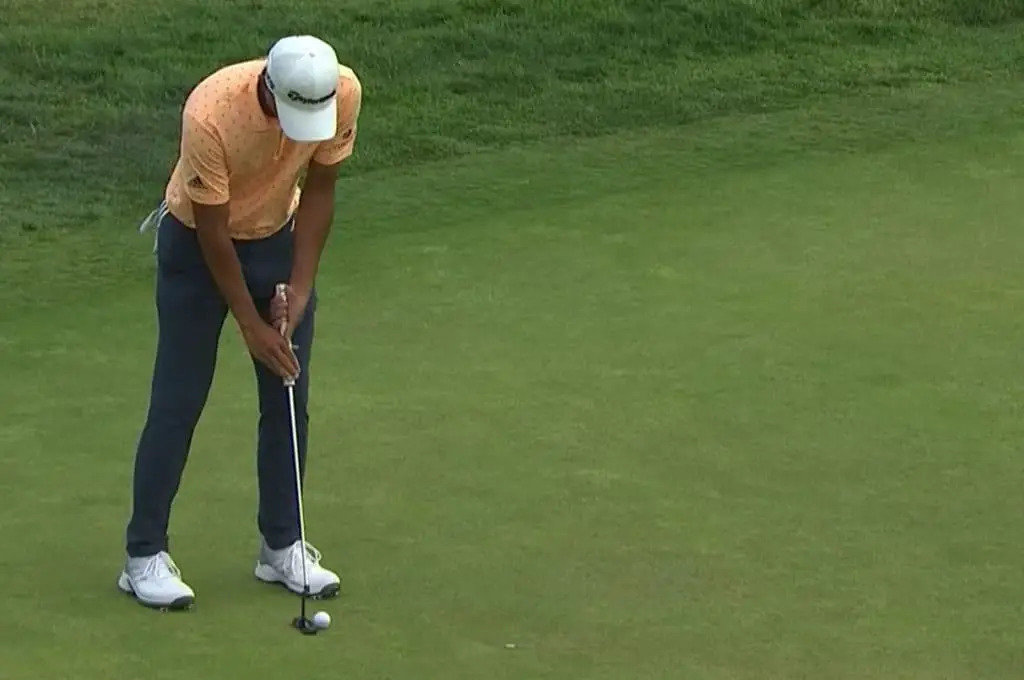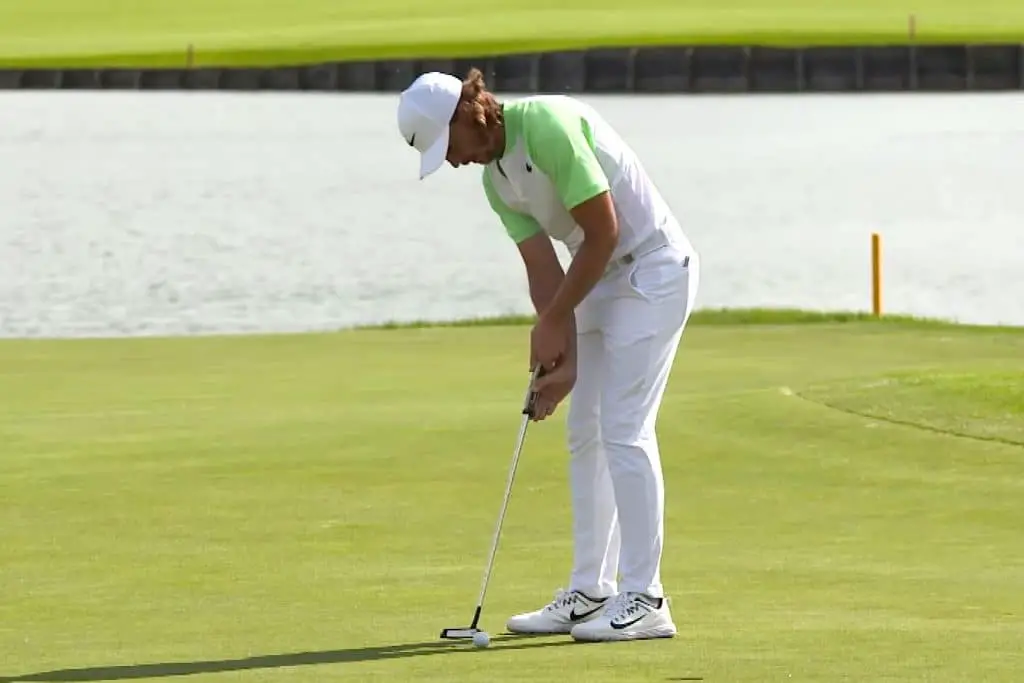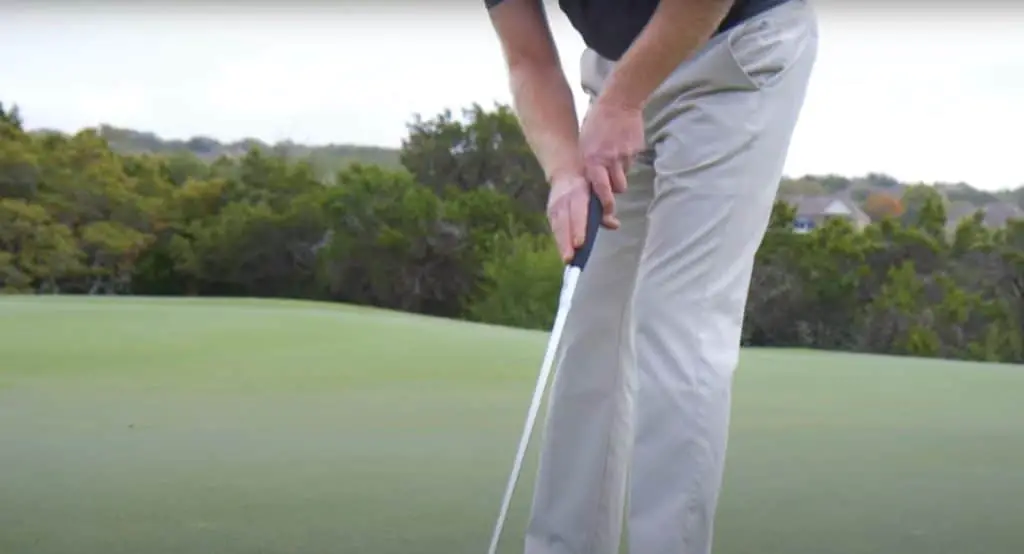What Is The Claw Putting Grip?
The Claw Putting Grip is a technique for holding a putter which involves grasping the putter in a ‘claw-like’ manner with your dominant hand (right hand for most golfers).
The point of holding the putter in this manner is to prevent your dominant hand from releasing too early during the follow-through, but there are other benefits as well. For instance, the claw grip makes your shoulders the primary driving force during the putting stroke, while your hands simply act as stabilizers that guide the putter head along the intended path.
With that being said, there are some drawbacks as well. In this article, we run through the pros and cons of the claw putting grip.
Claw Putting Grip Pros

1. It prevents the right hand from releasing too early during the follow-through
This problem is more common with professionals, but it can affect amateur golfers as well.
In essence, one of the most destructive moves that you can make when putting is to allow your right hand to release the putter head too early. It’s almost the equivalent of flipping the putter head with your right hand during the follow-through.
Said another way, an overactive right hand can cause your wrist angles to break down, which leads to major consistencies at impact. Thankfully, the claw putting grip is the perfect remedy to this particular problem.
When holding a putter with a claw grip, the left hand becomes the dominant hand in the stroke, while the right-hand acts primarily as a guidance assistant. Said another way, the left hand assumes almost all control, while the right hand simply helps the putter move along the correct path during the backswing and the follow-through.
2. It is easy to control the stroke with your shoulders
Of all the putting techniques that you can use, the claw is arguably the best for making the stroke less ‘handsy’ and more shoulder dominant. This is one of the main reasons that Justin Rose made the switch to the claw grip.
Instead of releasing your hands through impact, the claw grip makes it easy to keep your hands stable, while you move the putter head back and through using your shoulders to drive the movement.
In essence, by switching to the claw grip you are switching to a putting style that can only work by rocking the shoulders back and through. If you suffer from twitchy or shaky hands, this shoulder-driven putting style could be a gamechanger.
3. The claw grip helps keep the putter face square
One of the best ways to keep a putter head square during the backswing and the follow-through is to hold the putter with your left hand only. When you do the left-hand-only drill, you should find that your hands and wrists work in unison, effectively maintaining the ideal wrist angle.
Importantly, the claw grip unlocks the same benefits, because the left-hand plays such a dominant role during the stroke.
Obviously, your right-hand does play a role but is only a supporting role. The main function of the right hand is to help hold the weight of the putter and act as a guiding force that helps keep the putter moving along the ideal path. However, it performs these two functions in a gentle and passive manner.
4. It can be a very efficient cure for the yips
The yips can be a destructive curse for both professionals and amateur golfers. If left unaddressed, the yips can make golf so unpleasant that players simply give up on the game entirely.
Fortunately, the claw grip offers one of the most reliable ways to eliminate the putting yips from your game. Best of all, you don’t even need to invest in a new putter to make this particular switch. All you need to do is figure out which version of the claw grip feels most comfortable to you, and then spend a few hours hittings putts on the practice green (or even a nice flat carpet).
Side note – Some people may argue that the yips is entirely mental. While this may be true, that doesn’t mean that you can simply wash away the mental scar tissue that exists inside the mind of a player that has suffered with the yips.
In most cases, a drastic physical and mental shift is needed. This could mean a new putting technique (like the claw), a new putter, or a new grip (like the FlatCat). The shift to a new putting technique provides a player with a fresh start. They can forget about all the mistakes of the past and focus on moving forward with a more robust method of putting.
Claw Putting Grip Cons

1. It might not work for right-hand dominant players
One of the primary benefits of the claw grip is that it prevents the right hand from playing an overactive role in the putting stroke. However, this can be problematic for golfers that rely on the coordination of their right hand to hit putts consistently.
In essence, the claw grip puts the left hand firmly in control, while the right simply helps to balance and guide the club. This left-hand dominant setup might not work for right-hand dominant players. Nevertheless, it is still worth experimenting with if you are currently experiencing a case of the yips.
2. Distance control can be tricky at first
When you first switch to the claw grip, you may find it difficult to dial in your distance control on long putts. This is partly because the claw can make putting feel quite rigid in comparison to a normal grip. It might also take you some time to learn how to accelerate through the ball like you normally would with a traditional grip.
3. You may start hitting putts left of the target
As mentioned earlier, the claw grip automatically ensures that your shoulders become the dominant force in your putting stroke. While this is desirable in most cases, it can become an issue if you set up with your shoulder closed to the target.
For instance, if you use the Tommy Fleetwood style claw grip, where the right hand actually sits underneath the putter grip, there is a strong possibility that your shoulders will be closed to the target at address, without you even realizing it.
If your shoulders are closed at address, there’s a good chance that they will also be closed at impact, leading to a pull tendency for some players. If you do become a victim of this particular tendency, focusing on shoulder alignment at address is a simple and effective way to resolve the issue.
Famous Players That Have Switched To The Claw
There are a number of players that have found success by switching to the claw grip. This list includes:
- Collin Morikawa
- Tommy Fleetwood
- Justin Rose
- Sergio Garcia
- Phil Mickelson
Final Thoughts
Switching to the claw can be a drastic change for any golfer. In most cases, the pros outweigh the cons, especially if you have an overactive right hand or a severe case of the yips.
Ultimately, the claw grip offers an inexpensive way to salvage your putting stroke and it has been a game-changer for professional players like Tommy Fleetwood and Collin Morikawa. It is definitely worth giving it a shot if you are currently struggling on the greens.


